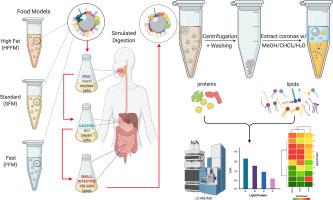当前位置:
X-MOL 学术
›
NanoImpact
›
论文详情
Our official English website, www.x-mol.net, welcomes your feedback! (Note: you will need to create a separate account there.)
Lipid and protein corona of food-grade TiO2 nanoparticles in simulated gastrointestinal digestion
NanoImpact ( IF 4.9 ) Pub Date : 2020-10-01 , DOI: 10.1016/j.impact.2020.100272 Roxana Coreas 1 , Xiaoqiong Cao 2 , Glen M Deloid 2 , Philip Demokritou 2 , Wenwan Zhong 1, 3
NanoImpact ( IF 4.9 ) Pub Date : 2020-10-01 , DOI: 10.1016/j.impact.2020.100272 Roxana Coreas 1 , Xiaoqiong Cao 2 , Glen M Deloid 2 , Philip Demokritou 2 , Wenwan Zhong 1, 3
Affiliation

|
In the presence of biological matrices, engineered nanomaterials, such as TiO2, develop a biomolecular corona composed of lipids, proteins, etc. In this study, we analyzed the biocorona formed on the food grade TiO2 (E171) going through an in vitro simulated gastrointestinal digestion system in either a fasting food model (FFM), a standardized food model (SFM), or a high fat food model (HFFM). Lipids and proteins were extracted from the biocorona and underwent untargeted lipidomic and label-free shotgun proteomic analyses. Our results showed that the biocorona composition was different before and after food digestion. After digestion, more diverse lipids were adsorbed compared to proteins, most of which were the enzymes added to the simulated digestion system. The corona lipid profile was distinct from the digested food model they presented in, although similarity in the lipid profiles between the corona and the food matrix increased with the fat content in the food model. The corona formed in the two low-fat environments of FFM and SFM shared a higher degree of similarity while very different from their corresponding matrix, with some lipid species adsorbed with high enrichment factors, indicating specific interaction with the TiO2 surface outperforming lipid matrix concentration in determination of corona formation. Formation of the biocorona may have contributed to the reduced oxidative stress as well as toxicological impacts observed in cellular studies. The present work is the first to confirm persistent adsorption of biomolecules could occur on ingested nanomaterials in food digestae. More future studies are needed to study the in vivo impacts of the biocorona, and shed lights on how the biocorona affects the biotransformations and fate of the ingested nanomaterials, which may impose impacts on human health.
中文翻译:

食品级二氧化钛纳米颗粒在模拟胃肠道消化中的脂质和蛋白质电晕
在生物基质存在的情况下,工程纳米材料,如 TiO2,会形成由脂质、蛋白质等组成的生物分子电晕。在这项研究中,我们分析了食品级 TiO2 (E171) 上形成的生物电晕经过体外模拟胃肠道禁食模型 (FFM)、标准化食物模型 (SFM) 或高脂肪食物模型 (HFFM) 中的消化系统。从生物冠中提取脂质和蛋白质,并进行非靶向脂质组学和无标记鸟枪蛋白质组学分析。我们的结果表明,食物消化前后的生物电晕组成是不同的。消化后,与蛋白质相比,吸附了更多种类的脂质,其中大部分是添加到模拟消化系统中的酶。电晕脂质谱与他们展示的消化食物模型不同,尽管电晕和食物基质之间脂质分布的相似性随着食物模型中脂肪含量的增加而增加。在 FFM 和 SFM 两种低脂肪环境中形成的电晕具有较高的相似度,但与其对应的基质有很大不同,一些脂质种类吸附有高富集因子,表明与 TiO2 表面的特异性相互作用优于脂质基质浓度电晕形成的测定。生物冠的形成可能有助于减少氧化应激以及细胞研究中观察到的毒理学影响。目前的工作是第一个证实生物分子的持久吸附可能发生在食物消化物中摄入的纳米材料上。需要更多的未来研究来研究生物电晕的体内影响,
更新日期:2020-10-01
中文翻译:

食品级二氧化钛纳米颗粒在模拟胃肠道消化中的脂质和蛋白质电晕
在生物基质存在的情况下,工程纳米材料,如 TiO2,会形成由脂质、蛋白质等组成的生物分子电晕。在这项研究中,我们分析了食品级 TiO2 (E171) 上形成的生物电晕经过体外模拟胃肠道禁食模型 (FFM)、标准化食物模型 (SFM) 或高脂肪食物模型 (HFFM) 中的消化系统。从生物冠中提取脂质和蛋白质,并进行非靶向脂质组学和无标记鸟枪蛋白质组学分析。我们的结果表明,食物消化前后的生物电晕组成是不同的。消化后,与蛋白质相比,吸附了更多种类的脂质,其中大部分是添加到模拟消化系统中的酶。电晕脂质谱与他们展示的消化食物模型不同,尽管电晕和食物基质之间脂质分布的相似性随着食物模型中脂肪含量的增加而增加。在 FFM 和 SFM 两种低脂肪环境中形成的电晕具有较高的相似度,但与其对应的基质有很大不同,一些脂质种类吸附有高富集因子,表明与 TiO2 表面的特异性相互作用优于脂质基质浓度电晕形成的测定。生物冠的形成可能有助于减少氧化应激以及细胞研究中观察到的毒理学影响。目前的工作是第一个证实生物分子的持久吸附可能发生在食物消化物中摄入的纳米材料上。需要更多的未来研究来研究生物电晕的体内影响,



























 京公网安备 11010802027423号
京公网安备 11010802027423号